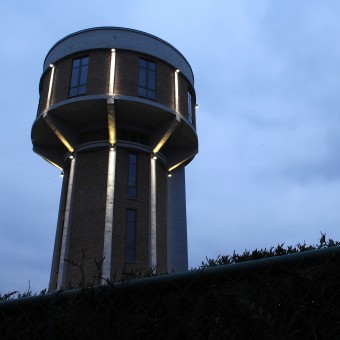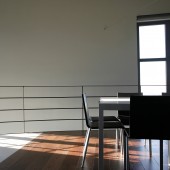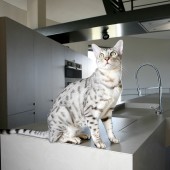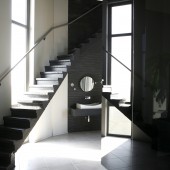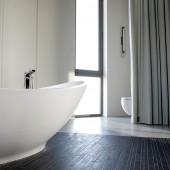DESIGN NAME:
Chateau D'eau
PRIMARY FUNCTION:
House
INSPIRATION:
An strong respect of the existing structure (architecture) and bold and minimal flemish design dear to the client.
UNIQUE PROPERTIES / PROJECT DESCRIPTION:
Conversion of an old watertower into a house.
A landmark building with huge efforts needed in isolation and integration of the technical installations and technology, a very diverse architecture language made of 8 sided spaces, cylindrical rooms, domes and 5meter high ceilings, a “vertical living life-style” and proximity of the national airport of less than 500 meters.
These are the main ingredients of this very singular Project. The challenge was to create a home from an industrial building with strong character and unusual spaces. All visible concrete was painted in dark grey (almost black) while new wall covering (isolation) where painted in a light warm grey. Wengé floor was used in the living room area and in the main bedroom.
6th floor – Terrace with a panoramic view
5th floor – Living room and kitchen
the tank was partially demolished (65%) in order to allow light to penetrate the living room, and kitchen. The space is wide open allowing the user to fully enjoy the 360° view.
4th floor – Bedroom
open room with an integration of the dressing as a monolithic mirror that disappears and “creates” more windows and views to the exterior.
3rd floor – Bath room
A huge walk in shower enclosed in black glass walls provide a sense of intimacy and coziness while multiplying the reflections of the windows
2nd floor – Gestroom & office
Partially finished, the office furniture has not been installed
1st floor – Technical room
Ground floor – Entrance hall and garage
OPERATION / FLOW / INTERACTION:
The program foresees two distinct profiles of users. The private and main user is the client, a couple living at the tower daily. Once or twice a month, part of the building is rented for very exclusive events targeting management people looking for a place to make workshops, high profile companies that seek a unique place to meet top clients in a near location to the airport. Every room is equipped with a sofisticated domotics system.
The integration of a flexible and advanced domotics system was essential to support actively the double program.
PROJECT DURATION AND LOCATION:
In a small terrain of 16m width by 20m long in the middle of a flat Belgian landscape, raises a 30m high water tower built between 1938 and 1941 for and by the village of Steenokkerzeel. It has been in service until the beginning of the nineties and was used by the Nazis during the 2nd world war as a “tour de guete”.
In 2004 a procedure was filled to protect and preserve the building witch the Royal commission for the protection and preservation of monuments and sites accepted.
The exterior of the tower was fully renovated to its initial state. Damaged concrete columns were repaired and painted, brick joints were completely removed and replaced and the windows in the floor top were enlarged.
Preliminary works for a complete renovation and conversion into a single family house started in 2008.
FITS BEST INTO CATEGORY:
Interior Space and Exhibition Design
|
PRODUCTION / REALIZATION TECHNOLOGY:
-
SPECIFICATIONS / TECHNICAL PROPERTIES:
-
TAGS:
Vertical living, industrial, home
RESEARCH ABSTRACT:
Internet and printed media mainly. The purpose was to understand what has already been done and tried before.
It was essential to understand how to deal with such unusual space shapes and dimensions? Domes, cylindrical rooms, octagonal shaped rooms and Peripheral stairs in most of the floors.
How to give a human dimension in a building that has not been design to have one?
How does one lives in a “vertical living” home?
How to convert it to a home, implementing my client’s own “desiderata” without altering the industrial character?
How to isolate (thermic and acoustics) a landmark witch you cannot touch the exterior?
How to integrate all the building technology without hurting the design?
All these questions had to be answerd in every step (and floor ;) of the design phase.
CHALLENGE:
Conversion of an old watertower into a house.
A landmark building with huge efforts needed in isolation and integration of the technical installations and technology, a very diverse architecture language made of 8 sided spaces, cylindrical rooms, domes and 5meter high ceilings, a “vertical living life-style” and proximity of the national airport of less than 500 meters.
Finding the right balance between the existing architecture and the integration of the new design elements, technology and technical installations is a real challenge. in this case that process was even more challenging due to the unique features of the building such as the shapes of each room.
ADDED DATE:
2010-11-15 04:44:36
TEAM MEMBERS (1) :
IMAGE CREDITS:
Mauro Brigham, 2010.
|



